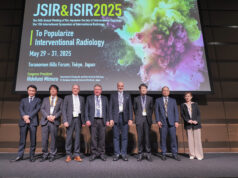A recent session at CIRSE 2018 sought to go beyond the headline findings from a number of recent randomised controlled trials (RCTs) in interventional oncology to define the future research directions for selective internal radiation therapy (SIRT; also called radioembolization), particularly with regard to dosimetry and patient selection.
Jose Ignacio Bilbao (Clinica Universidad de Navarra, Pamplona, Spain), presenting on the SARAH (Sorafenib vs. radioembolization in advanced hepatocellular carcinoma) trial from France also compared it with data from the randomised controlled trial SIRveNIB (selective internal radiation therapy vs. sorafenib) study from Asia, that dealt with a similar research question.
The SARAH trial directly compared the efficacy of SIRT using yttrium-90 (Y-90) resin microspheres (Sirspheres, Sirtex) to sorafenib (Nexavar; Bayer). SIRveNIB compared the safety and efficacy of radioembolization and sorafenib in patients with locally advanced hepatocellular carcinoma. The primary endpoint of both trials was overall survival.
Results from SARAH showed that local treatments of SIRT did not lead to a planned superiority difference in overall survival, compared with standard-of-care systemic therapy with sorafenib. However, SIRT had far fewer side-effects and patients who received this treatment had a significantly better quality of life. Very similar data emerged from the SIRveNIB trial, which also failed to meet its primary endpoint.
“This has led to the most recent EASL Practice Guidelines (Journal of Hepatology, 2018) to recommend that radioembolization should not be used to treat hepatocellular carcinoma [in this setting], so this is not good news,” Bilbao said.
Looking more carefully at the data beyond the headline findings, Bilbao stated that in the per-protocol analysis of SARAH, 26.6% of patients did not receive the intended treatment of SIRT and 7.2% of patients did not receive sorafenib. Similarly, in SIRveNIB, 28.6% of patients did not get the intended treatment of SIRT and 9% of patients did not get sorafenib. “This is an important bias in my opinion,” Bilbao said, while also showing that there were some patients in the SARAH trial who were enrolled despite their poor condition. Others, he said, were also undertreated.
Despite these shortcomings, Bilbao described SARAH as “a very positive study” that has shown the benefits of SIRT in certain subgroups of patients such as those with under 25% tumour burden, good liver function as measured by ALBI grade and those that had greater than or equal to 100Gy tumour absorbed doses.
Pointing to what can be learned from the outcome of these trials, Bilbao stated that both SARAH and SIRveNIB had been designed to show the superiority of SIRT. “There is no information regarding non-inferiority of the therapy that can be gleaned from these studies,” he said.
Speaking in particular about the Technetium-99m macro-aggregated albumin scan and refined dosimetry, Bilbao asked: should a bad uptake exclude patients for Y-90 treatment? Is it useful just for the evaluation of lung shunting? How can the activity be accurately evaluated for a personalised treatment?
“SIRT has clear local efficacy with regard to tumour response, and progression within the liver. It should be indicated in locally advanced hepatocellular carcinoma with a better patient selection and treatment optimisation. Refined dosimetry will have a role to play,” Bilbao concluded.
SIRFLOX, FOXFIRE and FOXFIRE Global trials
Thomas Helmberger (Klinikum Bogenhausen, Munich, Germany) analysed the SIRFLOX, FOXFIRE and FOXFIRE Global trials.
“The combination of chemotherapy plus a biological agent is standard first-line therapy in colorectal cancer. The liver is the dominant target site for metastatic colorectal cancer and hepatic metastases are the main cause of tumour-related death. Radiotherapy is a potent therapy in cancer,” he said to explain the rationale behind the use of SIRT and the design of these trials.
The FOXFIRE, SIRFLOX and FOXFIRE Global randomised studies evaluated the efficacy of combining first-line chemotherapy for metastatic colorectal cancer with SIRT using yttrium-90 resin microspheres in patients with liver metastases. The combined analysis comprised data from the SIRFLOX study and data from FOXFIRE and FOXFIRE Global. However, data from the combined analysis showed that there was no statistically significant difference between the overall survival of patients who received SIRSpheres plus standard first-line chemotherapy and those who received chemotherapy alone.
Outlining some of the new questions that the analysis provoked, Helmberger asked: did the study protocol tend to promote the inclusion of patients with potential extrahepatic disease and potential progressive disease? Is reducing the hepatic tumour load by SIRT as liver-directed therapy also reducing extra hepatic progression? Is failure to improve overall progression-free survival really a failure of systemic chemotherapy since extrahepatic disease is targeted by this treatment? Is RECIST 1.1 systematically underestimating the therapeutic effects resulting in deterioration of results?
SIRFLOX is the largest randomised controlled trial in the world with a medical device in interventional oncology; it was well constructed and monitored; reflected an up-to-date chemotherapy regimen—and included more than 1000 patients said Helmberger in outlining the strengths of the study.
Commenting on its weaknesses, Helmberger alluded to the unusually large number of patients who were at high-risk for poor outcomes in the SIRT arm (such as the nearly 36% of those who had extrahepatic metastases, or the over 50% who had the primary tumour in situ). In addition, there was also a significantly intensified systemic chemotherapy regimen in the non-SIRT arm that may have contributed to an imbalance treatment between the two arms of the trial which might have led to the control arm seeing better results, he pointed out.
“The impact of study design and patient stratification is crucial. Comprehensive registry data may provide more robust information in complex scenarios compared to randomised controlled trials,” Helmberger stated.
SORAMIC trial
Roberto Iezzi (Catholic University, Rome, Italy) presented on the phase II SORAMIC trial, a large investigator-initiated randomised controlled trial that evaluated sorafenib in combination with local microtherapies (either radiofrequency ablation in a curative group, or SIR-Spheres in a palliative group) for the treatment of unresectable hepatocellular carcinoma (HCC), and guided by Primovist-enhanced magnetic resonance imaging (MRI). The primary endpoint of the curative arm was time to recurrence whereas for the palliative arm it was overall survival.
“SORAMIC combines the most promising novel diagnostic and therapeutic approaches in HCC treatment available to date: diagnosis with hepatocyte specific contrast agent Primovist; microtherapy with SIRT or radiofrequency ablation; and systemic treatment with tyrosinekinase inhibitor sorafenib,” Iezzi explained.
Results from the palliative group presented earlier this year revealed that SIRT in combination with sorafenib did not provide a significant survival benefit compared with sorafenib alone in patients with advanced hepatocellular carcinoma.
However, although the overall survival rates in the total patient population did not differ significantly between treatment groups, subgroup analyses suggested possible survival benefits with adding SIRT to sorafenib in some patient groups. It was these subgroups that Iezzi emphasised at CIRSE.
“There was a survival benefit in younger patients, those with a non-alcoholic aetiology of the cirrhosis, and those with no cirrhosis at all,” he said.
Furthermore, this trial confirmed that the addition of SIRT to sorafenib is safe and feasible with a toxicity similar to sorafenib alone. Summing up, Iezzi pointed out that these results could justify and encourage the combination of SIRT with also other systemic anticancer treatments, such as immunotherapy. In particular, continuous tumour radiation delivered by SIRT may have immunomodulative effects so that, combined with immune checkpoint inhibition or T cell therapy, could potentially result in improved clinical outcomes.
Further, as this was a palliative study, there was no post-treatment imaging required and therefore, there was potentially no informations on tumour response, downstaging, total time to progression and progression-free survival, Iezzi noted. These parameters could demonstrate the superiority of combined group.
“My take-home message is that we have to perform really tailored treatments based on the indications and appropriate selection of patients. This trial highlighted that liver function clearly is the key. The evaluation of SORAMIC data is still ongoing so this is a continuing discussion,” he said.












